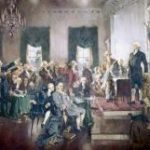This video playlist is part of the New-York Historical Society’s Academy for American Democracy, an educational initiative focusing on history and civics education for sixth grade students. Videos explore the ideals of democracy, civic participation, the evolution of Ancient Athenian and American democracy, and the power of the people within democracies.
Making the Constitution (CKHG Unit)
Students who listen to this Grade 2 Core Knowledge History and Geography unit discover that Americans had a difficult task at hand after winning the Revolutionary War: they had to figure out a better way to govern themselves. Such leaders as James Madison, George Washington, Alexander Hamilton, and Benjamin Franklin traveled to Philadelphia to meet at the Constitutional Convention, with the goal of creating a new government. Students learn that the talks were held in secret in Independence Hall and that American leaders argued about many issues until they agreed to approve a new Constitution. They then hear that James Madison (whom we call the Father of the Constitution), along with John Jay and Alexander Hamilton, wrote the Federalist Papers to explain the document’s merits and to persuade the states to vote for it. Students find out that the states did finally approve the Constitution; that Madison wrote a Bill of Rights that was added to it; that the Constitution gives the American people the right to decide what the laws should be for our country; and that we can still amend it today.(5 lessons)
The Constitutional Convention of 1787
In this unit, students will examine the roles that key American founders played in creating the Constitution, and the challenges they faced in the process. They will learn why many Americans in the 1780s believed that reforms to the Articles of Confederation were necessary, and the steps taken to authorize the 1787 Convention in Philadelphia. They will become familiar with the main issues that divided delegates at the Convention, particularly the questions of representation in Congress and the office of the presidency. Finally, they will see how a spirit of compromise, in the end, was necessary for the Convention to fulfill its task of improving the American political system.
Dialogue on the Fourteenth Amendment
The American Bar Association Dialogue program provides lawyers, judges and teachers with the resources they need to engage students and community members in a discussion of fundamental American legal principles and civic traditions. This Dialogue on the Fourteenth Amendment is composed of three parts:
Part 1: Equal Protection and Civil Rights – Participants discuss the equal protection clause of the 14th Amendment and consider how Congress, through federal legislation, has worked to help realize its constitutional promise.
Part 2: Incorporating the Bill of Rights examines the concept of incorporation. Using a case study of Gitlow v. New York, this section provides a guide to how courts have applied the Bill of Rights, selectively, to the states using the 14th Amendment.
Part 3: Ensuring Equality and Liberty explores how the 14th Amendment has been interpreted by courts to protect fundamental freedoms, including individuals’ right to marry.
American Legal History: Colonial Era to 1800
Larry Kramer, former Dean of Stanford Law School and constitutional scholar, discusses American legal history, beginning with Marbury v. Madison.
Women During the American Revolution

This short video illustrates the degree to which women actively participated in the American Revolution. In response to the Stamp Act, American colonists agreed to stop importing British goods and the colonial women led the boycotts of tea, fine cloth, and other consumer goods. Women began to think of themselves as “Daughters of Liberty.” Professor Rosemarie Zagarri explains how male political leaders came to acknowledge the political capacity and potential of women during this era.
‘It’s An American Thing!’
Looking for ice breakers for classroom starters? Can 30 seconds make a difference in your classroom? Constituting America’s Best High School PSA by Dakare Chatman, “It’s an American Thing!” creates thought, excitement and a challenge for your students. You need a method to begin class? Look no further.
‘Speech Is More Than Speaking’
“Speech Is More Than Speaking” is a We The Future Contest winner for Best Short Film by Jacob VanDerwerken. What is Freedom of Speech if you cannot speak? Using American Sign Language, Jacob VanDerwerken explains the First Amendment’s Freedom of Speech is not just verbal language. This video is a discussion starter for students and adults.
The Constitution as a Fulfillment of the American Revolution

This short video challenges the notion that the Constitution was a conservative reaction to the democratic ideals of the American Revolution. The Revolution generated constitutional discussion in the states, where legislators explored the nature of executive power, and other constitutional questions. In light of this constitutional innovation, Professor Jack Rakove maintains that the Constitution of 1787 was the culmination of—not a reaction to–the Revolution of the late 1770’s.
Reconstruction and The American Founding
Explore primary source documents in the ConSource digital library to see how the provisions of the 13th, 14th, and 15th amendments are connected to the issues and debates discussed during the revolutionary and constitutional periods.